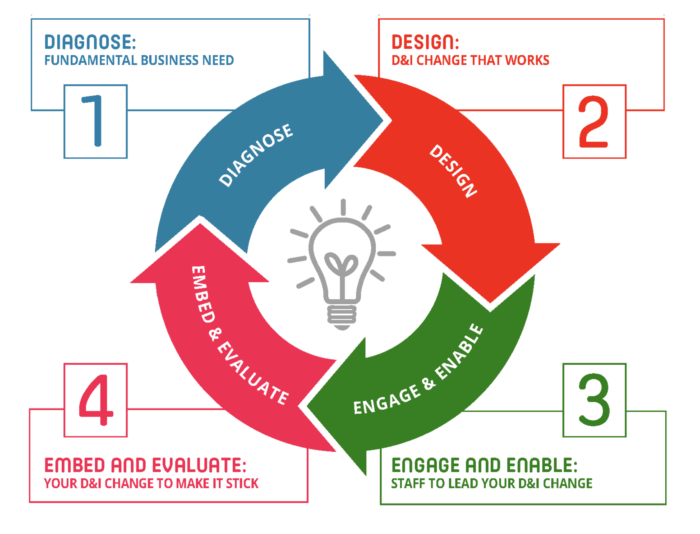What’s your diversity and inclusion strategy?
Posted on 13 Sep 2023
By Matthew Schulz, journalist, Institute of Community Directors Australia

Australia’s not-for-profit peak for diversity and inclusion in the workplace has outlined several actions organisation can and should take now to make their organisations more open.
The Diversity Council Australia (DCA) is on a mission to help organisations do better when it comes to diversity and inclusion, driven by a belief that those traits are good both for people and for business.

Previously known as the Council for Equal Opportunity in Employment when it had a charter to promote equality for women, the council now advocates for diverse workplaces generally, with the backing of some of Australia’s most prominent businesses and their advocates.
DCA chief executive Lisa Annese nominated three key areas not-for-profit directors and leaders should address to help their organisations become more diverse and inclusive.
“Directors and leaders seeking to foster a more diverse and inclusive workforce need to focus on three things: taking it seriously, funding it, and setting measurable objectives.”
On that first point, organisations needed a “genuine commitment” for change to occur.
“Organisations often underestimate how much work is involved in ‘D&I’ and there is a tendency to just group it in with human resources, or hand it to a few keen people, but diversity and inclusion isn’t an add-on. It requires transformational cultural change,” Ms Annese said.
To assist, the DCA has developed a “Change at Work” model, using an evidence-based model to guide organisations through four main steps:
- Diagnose: identify needs and opportunities and identify success
- Design: assess organisational and staff readiness and gaps
- Engage and enable: deploy staff to lead change
- Embed and evaluate: adapt policies, processes and systems and measure the effectiveness of changes.

Addressing the second point, Ms Annese stressed changes were possible only with adequate funding.
“Leaders need to approach D&I as they would anything else that required high-level transformation and resource it properly if they want to see tangible results.”
To get results, DCA recommends organisations set goals for change, such as equal representation of women in leadership or an inclusive recruitment strategy.
Finally, Ms Annese said that leaders wanting to improve diversity should embrace an intersectional approach, which accounted for the many aspects of a person’s identity, such as race, culture, religion, age, care-giving, disability and sexual orientation, which had the potential to expose them to “overlapping forms of discrimination or marginalisation”.
“Intersectionality … recognises that diversity and inclusion initiatives should be designed to work across diversity dimensions.”
Ms Annese also said organisations needed to keep working on their commitments.
“Diversity and inclusion needs to be more than just a ‘set and forget’ policy that sits on the shelf and is never reviewed, because this space is constantly evolving, and workplaces will need to put in the work and the proper resourcing if they want to see tangible change.
“As the research clearly shows, the alternative is less innovation, poor talent attraction and retention, falling behind your competition, and even potential legal risks.”
Diversity and inclusion can give your organisation a boost
Pursuing a diverse and inclusive agenda, including at leadership level, has the potential to bring many benefits, the DCA argues.
Ms Annese cited DCA’s 2021–2022 Inclusion@Work Index, which had demonstrated “an incredible impact on workplaces, from employee wellbeing to business performance”.
Its data showed that workers in inclusive teams were:
- four times less likely to leave their job in the next 12 months
- 10 times more likely to be “very satisfied”
- four times less likely to feel work had a negative impact on their mental health
- five times less likely to experience discrimination and/or harassment
- 11 times more likely to be “highly effective”
- 10 times more likely to be innovative
- six times more likely to provide excellent customer service
- four times more likely to work harder.
She cited another study by consultants McKinsey & Company which showed that companies led by gender-diverse teams outperformed others by 21%, while those with ethnically and culturally diverse leaders boosted performance by a third.
She said without diversity, boards were putting their missions at risk.
“If an organisation’s board isn’t diverse, they risk having groupthink. If everyone is thinking similarly, you’re more likely to miss risks, and less likely to problem-solve creatively.
“People with a diverse range of lived experiences bring different ways of thinking to a conversation, challenge each other, and can help spot risks and present solutions in unique ways.
“But it goes beyond just having, say, a token woman, for example. You need a critical mass so people from diverse backgrounds feel safe speaking up. Research shows that you need an average of at least three women, or 30% of members, on a board to see an increase in innovation.
She said diverse and inclusive organisations had a strong competitive advantage.
“We know that the next generation of employees are seeking out companies that perform well in terms of D&I. Companies that perform poorly in this space will struggle to attract and retain talent, as well as putting themselves at risk of discrimination, harassment and bullying complaints.”
Case studies and research demonstrate effectiveness of diversity strategy
The DCA has compiled several examples of organisations and businesses that have adopted a more welcoming approach and seen great results.
Those case studies explore how organisations are creating an accessible culture, promoting gender and sexual diversity, supporting workers affected by family violence, improving disability access, raising First Nations cultural awareness, boosting parental leave provisions, employing more refugees, and reducing sexism and sexual harassment.
The DCA has also conducted extensive research into diversity, looking at culturally and racially marginalised women, the impact of artificial intelligence, racism at work, inclusion and mental health, gender pay gaps, family violence and diversity analysis methods.
While many of the resources are free, the DCA provides additional help to its paid members, with 50% discounts for not-for-profits and charities registered with the Australian Charities and Not-for-profits Commission. Fees start at $915 a year.
More information
DCA resources: Inclusive recruitment toolkit | Change at Work model | Research
Research links workplace inclusion and flexibility to employee mental health